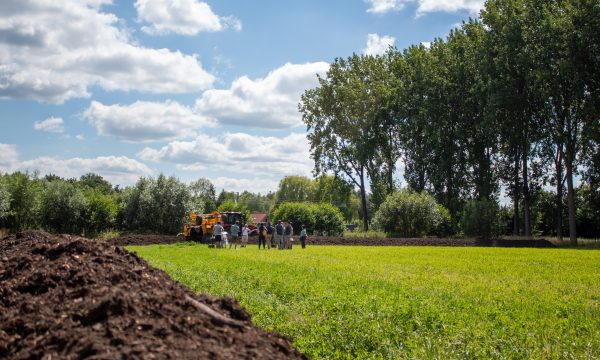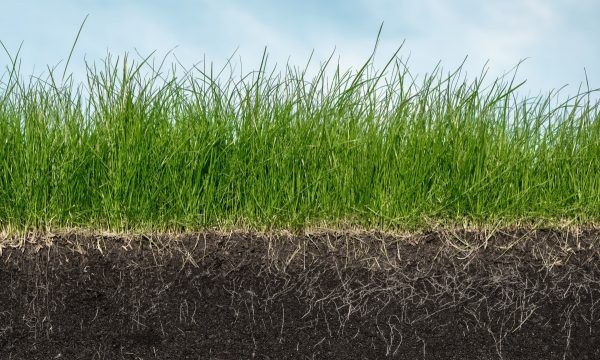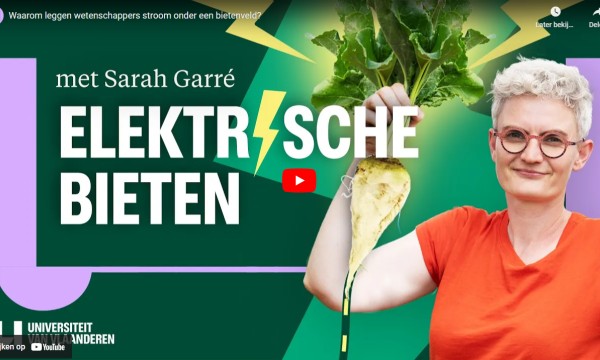Project news How can we nourish the soil under strict phosphate norms and high fertilizer prices?

Research offers 8 tips for an optimal fertilization strategy using the principles from organic farming
Reduced phosphorus fertilization standards since the Fifth Fertilization Action Plan in Flanders, high phosphorus stocks in many Flemish fields, and increased fertilizer prices present a major challenge to all agriculture, and specifically organic farming. How can the soil be sufficiently nourished without damaging the environment?
Commissioned by the Flemish Land Agency (VLM), researchers from ILVO, UGent, Inagro, Pcfruit and the Belgian Soil Services (Bodemkundige Dienst België) conducted a series of tests, a literature study and a benchmark with foreign countries. From that research, 8 good practices for sustainable fertilization emerged.
Do: Use green cover mixtures with leguminous plants in crop rotation
To absorb residual nitrogen from the soil, the use of green cover crops as catch crops in crop rotation is already a well established practice. Moreover, green cover crops also effectively apply organic matter without external phosphorus inputs.
When choosing a green cover crop, a species-rich mixture is recommended. This produces better results than a two-species mixture or a single green cover crop. A mixture with a leguminous species is ideal because that green coverer provides nitrogen in addition to organic matter.
Thus, green cover crop mixtures can have a positive impact on nitrogen availability in the soil and even on the development of the subsequent crop. However, dry weather conditions, late seeding or inappropriate seeding timing can weaken that effect. Green cover crop incorporation must also be done properly so as not to hinder the development of the follow crop. Taking into account the nitrogen delivery from the under-worked green cover is necessary for proper nitrogen fertilization rates. Thus, experience and knowledge are important to fully utilize the fertilizing and soil improvement potential of a green cover crop (mixture).
A green cover crop mixture with legumes is also suitable for the utilization of residual nitrogen after the main crop. Our tests show no increased risk of exceeding the nitrate nitrogen residue standard.
Do: Sow temporary grass-clover as a rest crop
Grass clover is an ideal rest crop in rotations with vegetables and forage crops. The intensive rooting brings a lot of organic matter and the clover binds atmospheric nitrogen, again without external input of phosphorus. If the follow crop is not an early crop, grass clover should be ripped in the spring. Because a lot of nitrogen is released after ripping, it is desirable to have a nitrogen-demanding crop to follow.
When tearing in the fall, as a function of an early crop in the spring, a green cover crop should be sown as a catch crop. Winter cereals can also be a follow crop of a grass clover ripped in the fall. It is not appropriate to apply a lot of animal manure after a temporary grass clover, as there is a risk of excessive nitrate nitrogen residue. If one must destroy the grass clover in the fall, shallow incorporation helps to reduce the nitrogen exemption and lower the risk of nitrate leaching.
Do: Consider a leguminous main crop
Leguminous plants require little or no external nitrogen fertilization. Post-harvest crops can also benefit from the residual nitrogen available in the soil via crop residues. Through their nitrogen-fixing capacity, leguminous plants also contribute to the build-up of soil organic matter. This is especially true for perennial, deep-rooting leguminous crops such as alfalfa. Mixed crops with grasses or cereals are interesting because of yield stability, richer above- and belowground biodiversity and the lower risk of excess nitrate nitrogen residue. After a monoculture legume, it is desirable anyway to follow a catch crop. Also, due to competition for soil nitrogen in a mixed crop, a legume fixes more atmospheric nitrogen than a monoculture.
Do: Fertilize accordingly, looking at nitrogen mineralization potential
Soil nitrogen mineralization potential is the amount of nitrogen potentially released upon decomposition of soil organic matter by soil life. Nitrogen mineralization potential varies greatly from plot to plot. The carbon content present in the soil plays a decisive role. The higher the carbon content in the soil, the higher the nitrogen mineralization potential.
Farmyard manure or compost help to build up the carbon content in the soil. Repeated application increases the nitrogen mineralization potential of the soil. Organic fertilizer feeds soil life. A diverse and active soil life contributes to good soil quality and releases nutrients (such as nitrogen) from the organic matter.The need for basic organic fertilizer is not the same everywhere, and not all types of fertilizer have the same nitrogen effect. Compost, for example, has a lower first-year nitrogen effect than farmyard manure. So carefully match what, how, when and how much you fertilize to the needs of the crop and, above all, look at the nitrogen mineralization potential of the soil.
In advice, nitrogen mineralization potential must also be taken into account. That potential is related to the general soil condition. An advisory system that relies primarily on crop requirements and mineral nitrogen supply appears to be inappropriate for an organic cropping system.
Do: In orchards, apply the cut of green cover crops to the black strip
In orchards, grass clippings from the green strip can be applied (multiple times) to the blacktop to build up organic matter and provide adequate nitrogen, without applying additional phosphorus. The grass clippings also stimulate soil life and have a positive effect on soil structure. Depending on the type of green cover crop supplied from the green strip, the nitrogen input to the black strip is higher or lower. A perennial grass clover also scores relatively well here and has the advantage that the sod is firm enough to drive over. If trees have high nitrogen requirements for leaf and fruit development in the spring, additional nitrogen may be needed in the form of fast-acting organic fertilizer. This is because nitrogen release from soil organic matter is slower during the still low spring temperatures. Organic fruit growers prefer fertilizers with low phosphorus content even then.
Grass clippings from green cover crops add potassium to the black strip in addition to nitrogen. With apple, vigilance is needed, because too high levels of potassium in the soil can cause a calcium deficiency in the fruit ("dot").Do: In orchards, work in compost or champost (superficially)
In most orchards, soil organic matter content is on the low side. This is because it is not easy to maintain the organic matter content in the blacktop through fertilization alone. Applying larger amounts of organic matter when replanting is a possibility, but the dosage must take into account the nitrogen effect of the applied forms of fertilizer to limit nitrogen losses through leaching.
Compost is preferable to farmyard manure and champost because of its more limited nitrogen effect. For basic fertilization during cultivation, all of these fertilizer forms are an option. Compost and champost are easier to incorporate when hoeing. The risk of nitrogen loss through volatilization is also lower than with farmyard manure.Do: Reintegrate crop and animal production
The most comprehensive measure put forward in the report is to bring plant and animal production together, with a view to optimizing nutrient cycling and increasing soil fertility. This can be done both at the farm level, through thoughtful crop rotation, and through collaboration between farms.
For example, organic livestock farms with temporary grass-clover and mixed crops with legume component in the rotation, can more easily build up a surplus of soil quality and nitrogen providing capacity that can be useful to farms with arable and/or vegetable crops. For example, livestock farms can cede manure or field or horticultural crops can be incorporated into a rotation with forage crops through plot swaps, or vice versa.The integration of animal and crop production brings a higher degree of self-sufficiency in nitrogen and organic matter, and thus less dependence on external fertilizer products. An important condition, however, is that the farms cooperating in this way are located close to each other, that they can make fair agreements on prices and compensation, and that it is a long-term cooperation based on trust.
Do: Reduce tillage
Working the soil less intensively, less frequently and less deeply is beneficial to overall soil quality, as well as to the conservation of plant nutrients. Indeed, intensive tillage can lead to excessive decomposition of soil organic matter and excessive nitrogen release. Additional benefits include energy savings during field work and less rapid soil desiccation in dry years. Reduced tillage requires a modification of machinery and more attention by the grower to appropriate crop monitoring and fertilization.
More info (in Dutch)
More information about this research can be found at www.vlm.be
- Comprehensive research report
- Summary research report
- Brochures about different cultivation systems
- P-brochure
///////////////////////////////////////////////////////////////////////////////////////////////////////////////////////////////////////////////////////////////
NV Vlaamse Landmaatschappij is an Externally Autonomous Agency of the Flemish Government under the authority of the Flemish Minister of Justice and Enforcement, Environment, Energy and Tourism.
For the Flemish Land Company, resilient open space full of life and a dynamic countryside are the answer to challenges such as urbanization, climate change and the decline of biodiversity. We strengthen open space and the countryside by investing in soil and water quality, biodiversity, space for food and social cohesion. We provide a quality landscape and healthy environment, where it is good to live and work and where there is room for relaxation.VLM was founded in 1988 and employs about 600 staff through 6 offices in Bruges, Ghent, Brussels, Leuven, Herentals and Hasselt.


